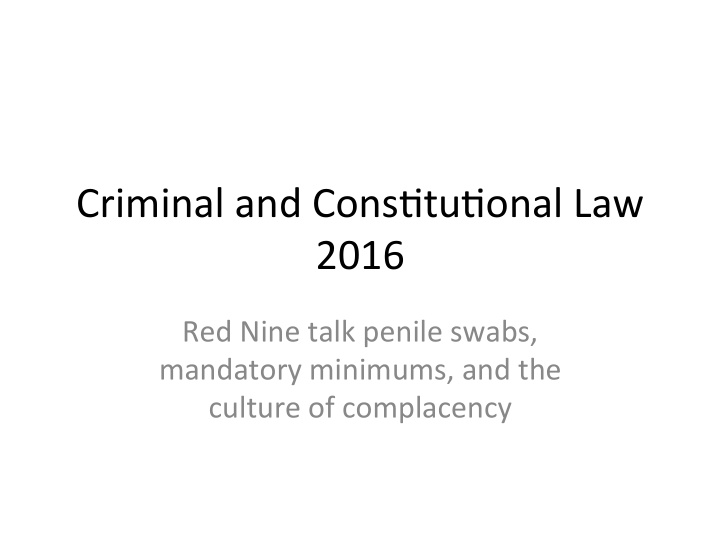



Criminal and Cons,tu,onal Law 2016 Red Nine talk penile swabs, mandatory minimums, and the culture of complacency
R. v. Saeed , 2016 SCC 24 • does the common law power of search incident to arrest authorize a penile swab of the accused? • Issue: can the police touch your genitals without a warrant?
Previous cases had held that: – taking mouth swabs; – taking dental impressions; or, – seizing hairs from an accused would be a significant intrusion of bodily integrity and could be an affront to privacy and dignity
Which of these would you call your privates?
S)llman Does Not Apply • Majority (Moldaver J.) decided that this was unlike a seizure of a bodily sample because: – Penile swab not designed to seize the accused’s own bodily samples – Penile swab is less invasive than a two hour long process for taking dental impressions – the complainant’s DNA degrades over ,me
“The facts of this case demonstrate the usefulness of a penile swab performed incident to arrest.”
As long as (1) arrest is lawful, (2) police have reasonable grounds to believe that a penile swab will give evidence, and (ie. search is truly incident to arrest) and (3) conducted in a reasonable manner, penile swab will not offend s. 8.
Dissent 1 • Karakatsanis, J.: – Swab of genitals is far more intrusive than a swab of the inside of the mouth or a pluck of hair from the head – Cannot use the usefulness of the evidence to infringe the privacy interest BUT, trial judge admi^ed it, so she did too
Dissent 2 • Abella J.: – If taking hair or teeth impressions is an “ul,mate invasion” of an individual’s privacy, how do we conceptualize a search whereby an individual is required to remove his clothes and swab his penis in front of two uniformed police officers – She agreed with Karakatsanis J.’s reasoning, but did not think that the evidence should be admi^ed
R. v. Lloyd , 2016 SCC 13 Challenge to the one year mandatory minimum sentence for a controlled substance offence on the basis that it is “cruel and unusual punishment” under s. 12 of the Charter
Once Again: vs.
Lloyd wins on s. 12 • There are reasonably foreseeable circumstances where a one-year sentence of imprisonment would be grossly dispropor,onate to the offence of possession for the purpose of trafficking a Schedule I substance
R. v. Lloyd • On the s. 7 argument, the Chief Jus,ce was “unable to accept the submission that the principle of propor,onality in sentencing is a principle of fundamental jus,ce under s. 7 of the Charter .”
R v. Jordan , 2016 SCC 27 • THE SPEEDY TRIAL: what does it mean in Canada? • From 1990-2016, s.11(b) was governed by a 4 part test intended to decide if the 9-18 guidelines had been breached
R v. Jordan, 2016 SCC 27 Overview: • Charges to conclusion of trial took 49.5 months • Ques,on becomes when will delay be so unreasonable that a stay will be warranted • Court divided 5:4 on how to deal with the “burden [of s.11(b) cases] on an already overburdened” Court System
R v. Jordan, the majority • In an a^empt to simplify, Moldaver, J. creates a new framework based on the concept that there is a ceiling beyond which delay will be presump)vely unreasonable • 18 months for cases in Provincial Court, 30 months for cases in Superior Court;
Moldaver, J. in Jordan • If 18/30 month ceiling exceeded: burden shims to Crown to rebut presump,on of unreasonableness on the basis of “Excep,onal Circumstances” • If delay is below the ceiling: defence may show unreasonable delay IF (1) defence took meaningful steps to expedite proceedings AND (2) case took markedly longer than it should have
Moldaver, J. on “Transi,on Cases” • The presump,ve ceiling applies to cases currently in the system, subject to two qualificaCons : – (1) if delay exceeded, Crown may sa,sfy the Court that there are transiConal excepConal circumstance – (2) If delay is below the ceiling (a) defence ini,a,ve and (b) whether the ,me markedly exceeds reasonableness will be applied contextually .
Recommend
More recommend